January 26, 2010
I am Zenon
The designs are interesting in their complexity, but the New-Agey lingo is way, way over-the-top.
That said, I like the form of the video. A stained glass designer talking about a given design. Simple. It would be interesting to imagine what other stained glass designers might sound like looking at their cartoons while explaining the design and iconographic choices.
December 26, 2009
Secular Window Saturday 2 - Sundials
Gecko Dial, circa 2003-2005
click to see larger image in new window

Part of the Stained Glass Sundials by Carmichael Flickrset, which is part of the larger Sundials by Carmichael's photostream, by Arizona Sundial Creator John Carmichael.
Make sure to check out Carmichael's Stained Glass Sundials website. It includes an incredibly rich archive of historical stained glass sundials. The annotations are copious and well organized. For example, this is the The Ambras Castle Dial, a Swabian sundial made in 1550, from the page for the 16th and 17th century stained glass sundials.
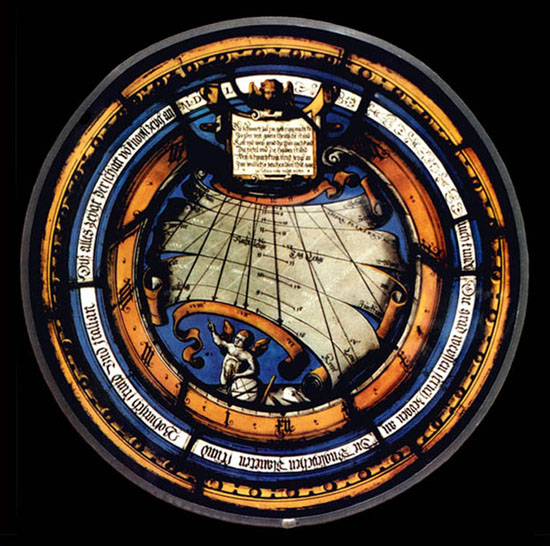
Another stained glass site worth a good long browse.. or two.
December 24, 2009
Lansdowne Church, Glasgow
Merry Christmas to all in the Christian world!
I just received a Christmas card with a photo of this window from Lansdowne Church, in Glasgow, Scotland. It's considered to be some of the best work of the Scottish stained glass designer, Alf Webster.
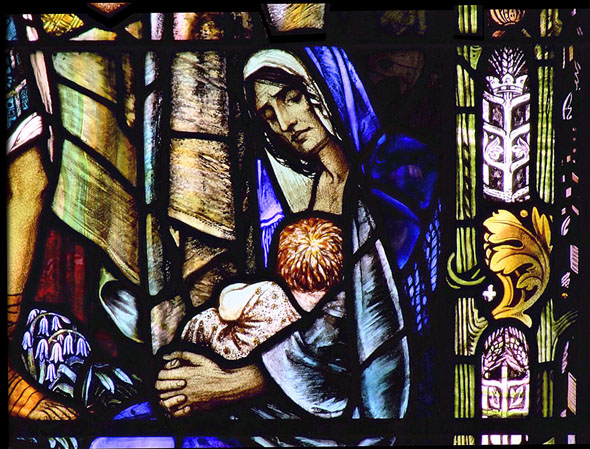
I don't think I've seen any other breastfeeding scenes in stained glass. There must be some. I know that breastfeeding scenes were fairly common in Medieval art, though I've never seen one in a Medieval stained glass window.
Some Gothic art with breastfeeding scenes can be seen on the www.art-breastfeeding.com website.
While this image is certainly appropriate for the Christmas season, being a mother and child, it is not from a nativity scene, nor is it even Mary and Jesus apparently. I've only seen it referred to as "Jesus in a Crowd".
The full panel with the mother and child image in context -
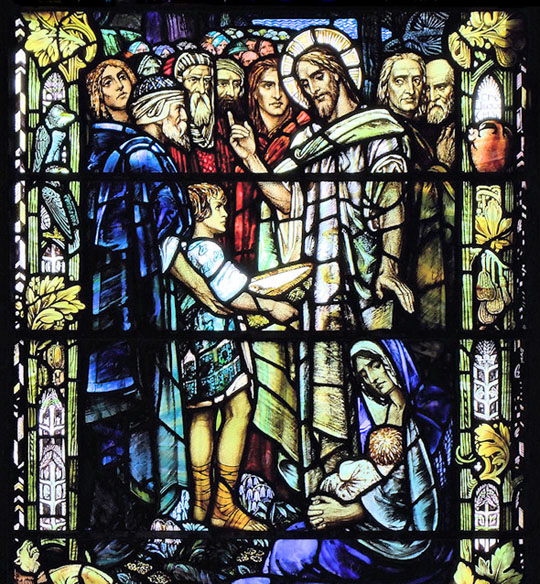
photo via Creative Commons license from Tom_Clearwood's Lansdowne Flickrset, part of the Lansdowne Flickr Pool. Worth a good long browse. Many nice details of the windows, and it's a good cause as it's all part of the conservation effort to save the Lansdowne church as a community center, while keeping all the windows in their original place.
December 19, 2009
Secular Window Saturday - Museum of the History of Science
Arms of The Royal College of Physicians Window from the Museum of the History of Science, Oxford, England.
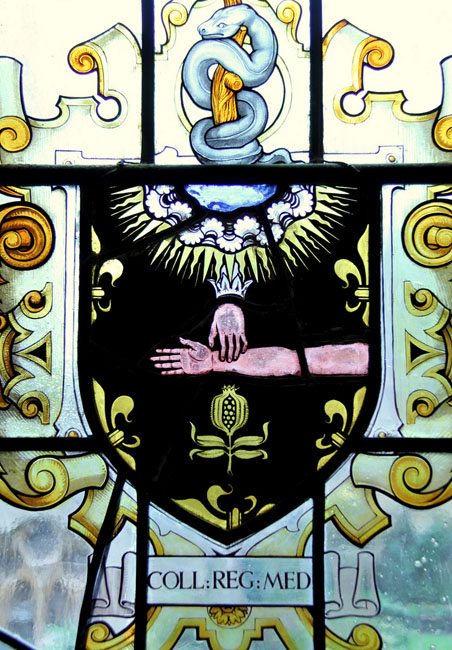
via creative commons license from flickrite kotomigd
See more windows and other images from this "Museum of the History of Science, Oxford" Flickr Group Pool. It includes almost 700 images from the museum, including more than 25 photos of the stained glass. Fascinating stuff.
September 03, 2009
Interesting site indeed
via Jim Miller on the H-Stained-Glass Network email forum, dated September 2, 2009 and named "An Interesting Site".
It is, indeed, an interesting site.
The origin of the site is a bit of a mystery, but the quantity and quality of the images is extremely impressive, especially in terms of doing comparative iconographic scenes. For instance, there are 30 different variations, over 4 web pages, of Jésus bénissant les enfants - Jesus Blessing the children.
One could hope for more information on the makers and sites, but with this many images and in such an interesting structure, who's to complain.
August 03, 2009
John K. Clark Video 2 - End of the Age of Innocence
Another excellent video with John K. Clark talking about one of his stained glass commissions, End of the Age of Innocence, created for a private residence in North Carolina.
Again, a very nice and simple way of telling the story of a window, as well as giving some technical background as well.
July 28, 2009
Louvre Database in English
I hear, via twittering, that the Louvre English Database was made live today.
If you type in a search for "stained glass", it brings in an impressive 76 results, and mostly small Swiss panels (some of my favorites - yum), but oddly, all the images are in black and white. At least the resolution is high enough to see a little detail.
I don't remember seeing any stained glass at the Louvre the one time I went many years ago, but I would have assumed that there was some its collection.
I never saw this room at the Louvre...
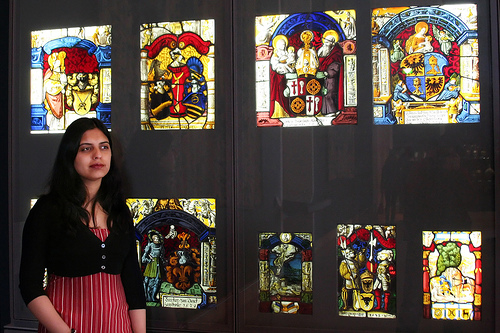
from Flickrite 'waqas' -
Stained-glass window bearing the arms of Uri and of the Holy Roman Empire
Central Switzerland, 1568
side by side in one panel (louvre black & white, and flickr picture)
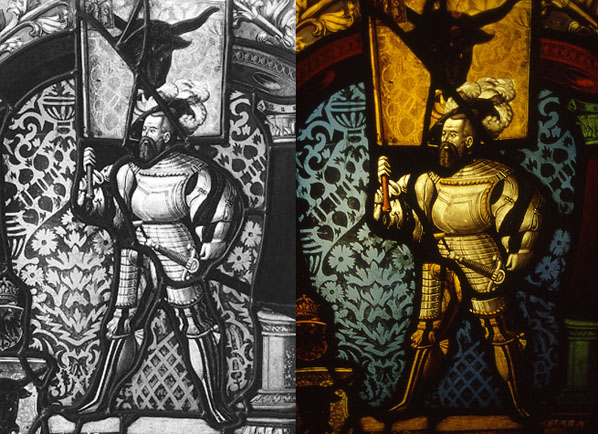
I like.
April 24, 2009
Morning Glass Design gets the Internet Thing
Another find via my new twitter account - http://twitter.com/vitreosity
Gordon Watt, of Morning Glass Designs, out of Aberdeenshire, Scotland, seems to get the whole internet thing. At the very least he's decided to dive in and use the tools available. Not only does he have a blog, but also a Flickr Projects Page, and also a Twitter account where I first came across him.
Look at a recent project for a window at Portlethen Kirk that was posted initially on his blog and then as a Flickrset. It will be interesting to see how this all develops.
April 20, 2009
Königsfelden Abbey
The April 2009 issue of Vidimus features an interview with medieval stained glass historian Madeleine Caviness, who is asked to name five places which they think every stained glass enthusiast ought to see before they die:
'Only five’ she exclaimed, 'It’s not easy but I’ll kick off with the Sainte Chapelle in Paris, Canterbury Cathedral in England, St Remi in France, Koeningsfelden in Switzerland [Fig. 9] and lastly, the extraordinarily rich windows of Cologne Cathedral that range from the 13th to the 16th century'.
I've only been to one of the sites, Sainte Chapelle, and I have to say I would not include it in my top 5 (bit too 'jewel box' for my taste). More surprising to me is that one of the places she mentions I'd never heard of - Koeningsfelden. I tried to do a search for it and came up with nothing at all. Not a thing. That is, until I realized I needed to search for it as Königsfelden, with the umlaut 'ö' instead of the anglicized 'oe'. That did it.
Eventually, I found the official website from the Convent Church Königsfelden, now a part of the Museum Aargau. Very nicely done too, especially the section called the Window Cycle. Every 14th century window is pointed out and described iconographically. There is a very nice St. Francis Sermon to the Birds. Also, a rather gruesome Beheading of St. John the Baptist, that features some early, rudimentary attempts at using linear perspective in stained glass design.
I also found a nice page of images giving some longer perspective shots in Wikimedia Commons:Category:Königsfelden Abbey
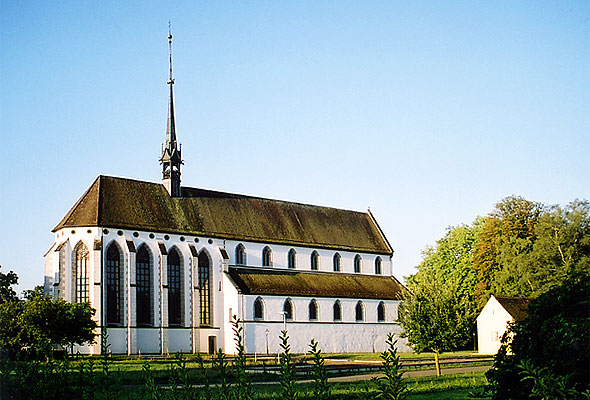
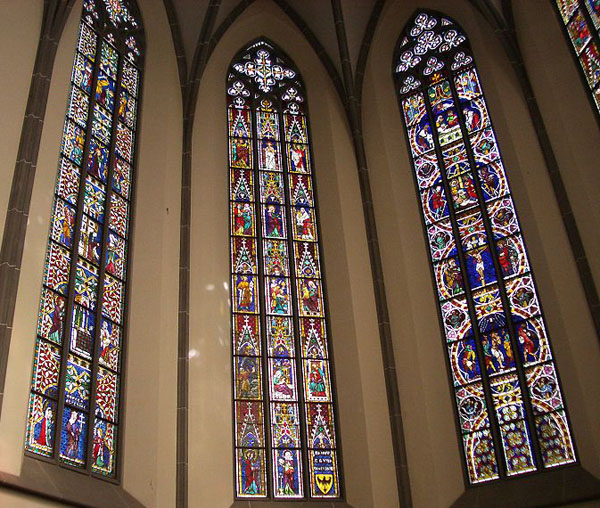
One curious detail stuck out in a quick look through the windows. The original windows date from the early half of the 14th century, but were extensively restored in 1900. The website gives a good indication what is original and what is new.
But the windows themselves tell us they've been restored. Notice the center bottom panel.
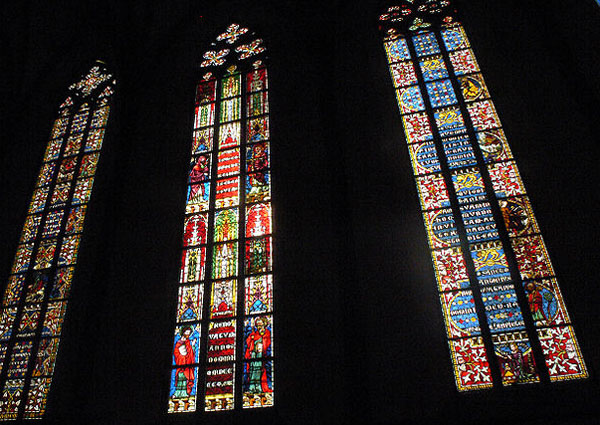
image from wikimedia commons site
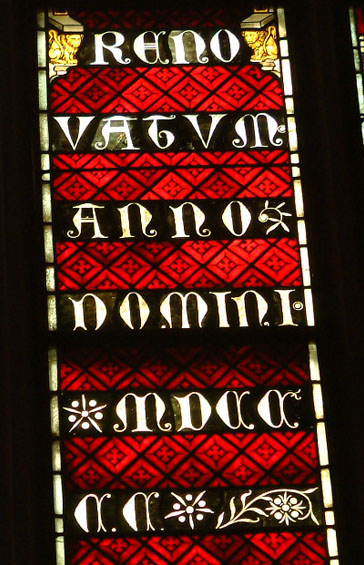
image from Flickr page with Königsfelden Windows
It says "Renovatum Anno Domini MDCCCC" and translates as "Restored in the Year of our Lord 1900". Now that's documentation.
February 27, 2009
Zoomifying Stained Glass
A few weeks back there was some buzz on the Yahoo Groups Stained Glass Forum about an interactive website called "A Bastion of Light", showing high resolution images of the stained glass of Christ Church Cathedral, New Zealand. It is impressive indeed.
Something rang a bell with this and I did a little research and found out the technology is due to a thing called Zoomify. There are links to examples of how Zoomify is being used on the Zoomify Customers webpage. Some are very nice, like the Morgan Library Medieval Illuminated Manuscript site, and the The Complete Works of Caravaggio, and the Getty Museum Online Exhibition of Flemish manuscript painting called Illuminating the Renaissance. I love this stuff, though I do have to be careful as this could be a serious timesucker.
As for making your own interactive pages using Zoomify, I downloaded the free version and tried it on one of my panels. It's surprisingly easy to use, at least if you've done some basic website creation yourself. You do need to know a little HTML, but not much.
It works especially well for my quarry/text panels, since I've never been able to show the full panel and still make the quotes readable without having a series of awkward links to other detail pages. So, here is the original ZoomifyExpress version of my 'Asheville Authors' Panel.
I'm impressed enough that I may get a paid version (seems like a good deal at $30) called Zoomify Design, as it would be nice to at least make it a black background, and add some text, like the 'Bastions of Light' site did.
All in all, I can see enormous potential for this type of stained glass display on the web.
[update February 28, 2009 - I did buy the ZoomifyDesign and turned the white background to a black background version of my 'Asheville Authors' Panel, which is more in line with the rest of my website. I also added some links to help navigation within my site. Unfortunately the process was not as easy as I thought it would be. So, the 'Express' version is easy to use, but you are left with a simple (and stark white) interface. The 'Design' version requires a bit more HTML knowledge to do even a simple design change like add a black background. You may also notice that the 'white' version runs a bit faster than the 'black' version. That's because the design is best done not in HTML but in Flash, which requires a more expensive version of Zoomify and you have to know Flash. I've been resistant to Flash for years, a consequence of my being an old-school animator.]
[update March 3, 2009 - I did two more pages using the same template I made for the Asheville Authors page. Here is the interactive version of my early Psychedelic Gothic panel and, for my friend Alice Johnson because I love her work and especially this panel, the Interactive Tibetan Wheel of Life panel.]
July 22, 2008
The Angels and Devils of Fairford
Recent postings on the Stained Glass Network email discussion forum have reminded me of a place I've always wanted to go - Church of St. Mary, Fairford, Gloucestershire, UK.
Though I've never visited the church itself, I've seen much of the glass though books and the web over the past 25 years, and the stained glass here is amongst my favorites. Amazing compositions and even more amazing details.
The most famous and most reproduced image from St. Mary's -
from The Last Judgement Window
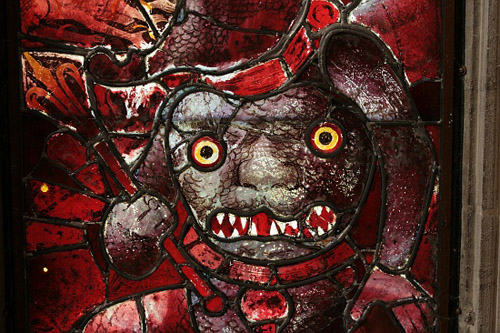
I probably first saw this image in the book Stained Glass, by Lawrence Lee et al, the well illustrated, oversized and always useful book published by Crown publishers and amazingly cheap as a used book on Amazon these days.
Best web source for St. Mary's images and info - photo gallery at sacred-destinations.com.
A quick scattershot of other images from a small selection of windows
below the fold...
Last Judgement Window
The most famous of the old windows - The West Window.
full image from Flickrite robin.croft
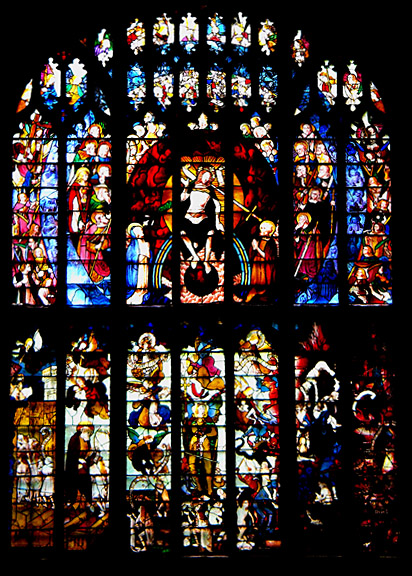
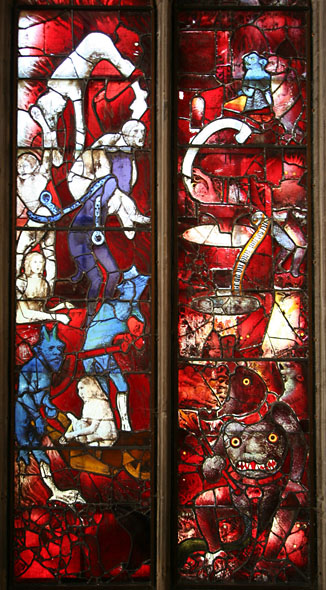
closer in, lower right - the famous image of Satan as Monster
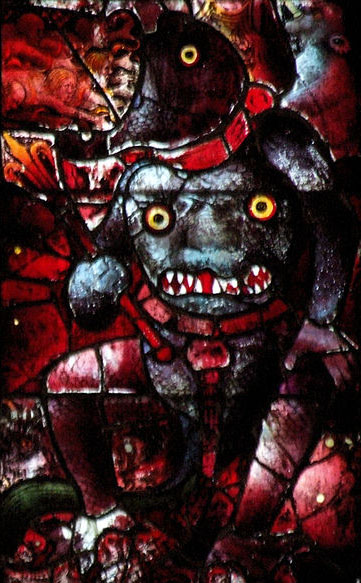
I've long been fascinated by this face in the torso of Satan - is this a depiction of decorated armor or does this image have anything to do with the Blemmyes, the medieval notion of a race of men with no head and a face in their torso.
Persecutors with Devils
Devils in the upper light of Window 27,
which has portraits of murderers and persecutors of the faith.
the window in full with the devils in the upper lights
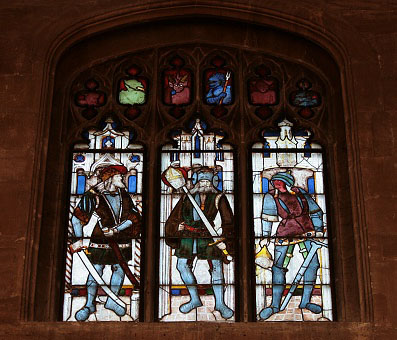

Image from the Devils page by Flickrite 'Robin.Croft'
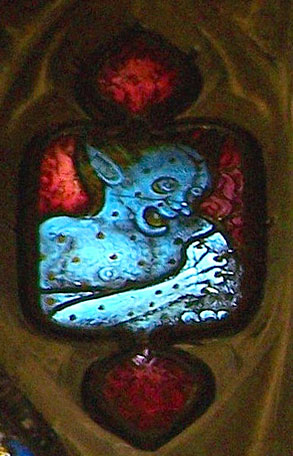
Angel Choir
From a set of Angel Choir figures of Fairford, also by Flickriste robin.croft
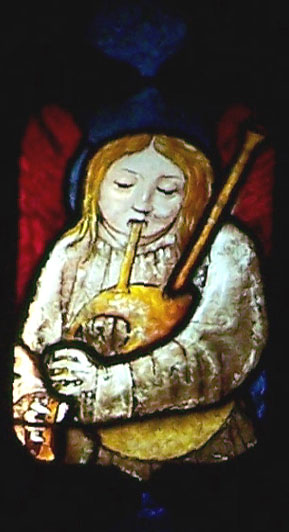
The Judgement of Solomon
Another West Window - even in the less famous images, there is something interesting - in this case, the visual art equivalent of breaking the fourth wall.
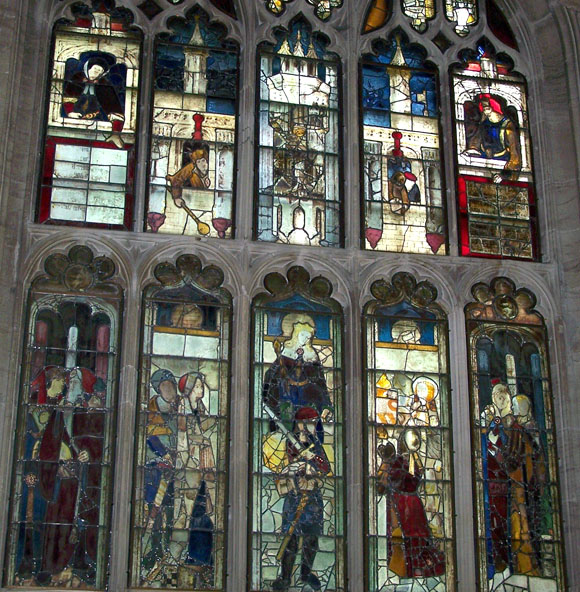
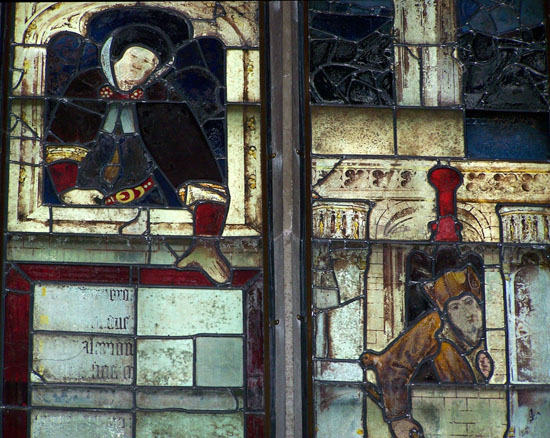
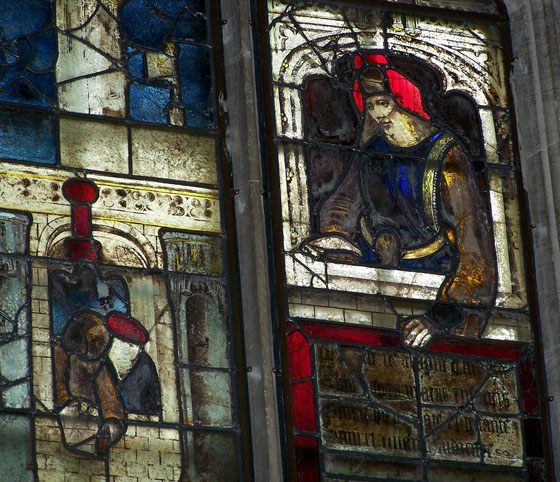
Resurrection Morning
In the east end of the Corpus Christi Chapel.
Again, I like these odd compositions with their shifting and disjointed perspectives.
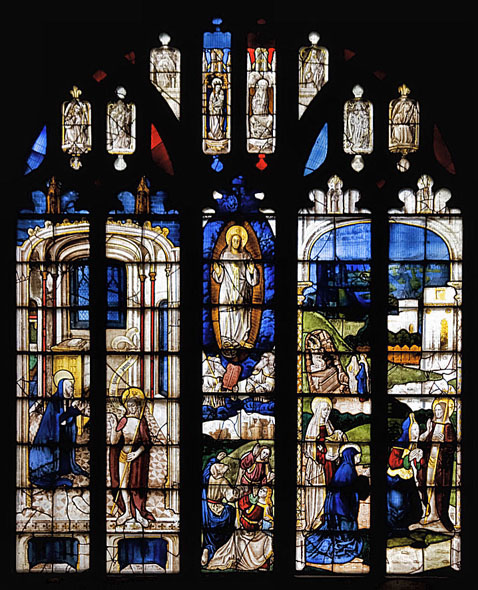
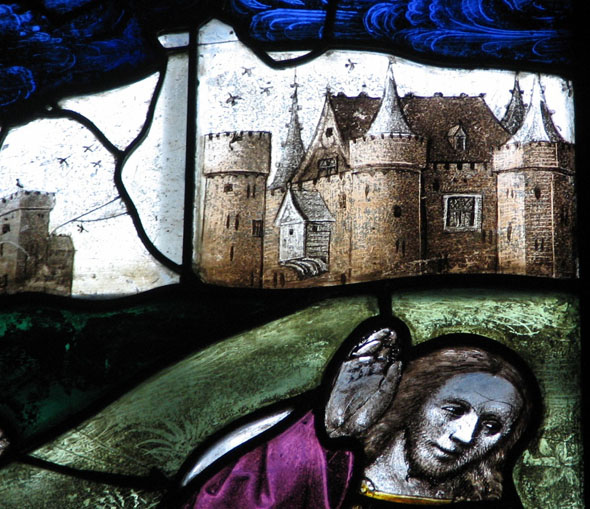
May 03, 2008
Norwich Stained Glass Website
via the April, 2008 edition of Vidimus -
Stained Glass in Norfolk and Norwich
Lots of nice details. A little cluttered and confusing to navigate at first, but worth the effort as there is a wealth of images and information. If you like the Norwich school, this site is essential. The Norwich School is known for it's unique style of glass painting. These examples, from Flickr, are pretty typical.
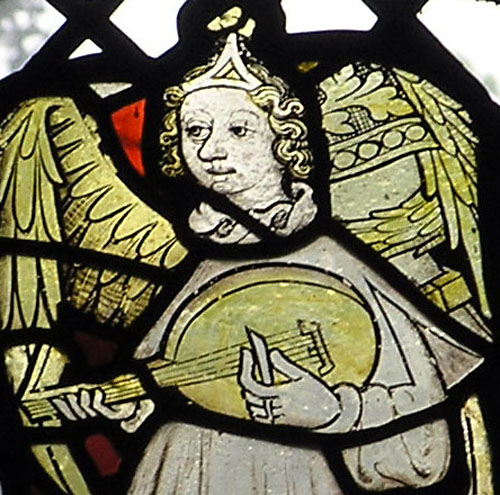
St John the Baptist Church, Timberhill, Norwich, Norfolk, UK - May 2006
from Flickrite E11y
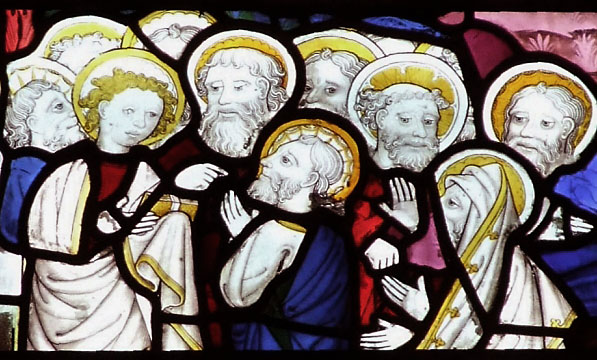
from a St. Peter Mancroft Flickrset
I've always loved the 14th-15th century Norwich-style faces in particular. By today's standards they would be considered too 'cartoony', but I think of it as emphasizing character over a superficial idea of beauty or proper proportion. This is seen clearly when compared to one of the modern replacement windows at St. Peter Mancroft. Give me the older 'cartoony' style any day.
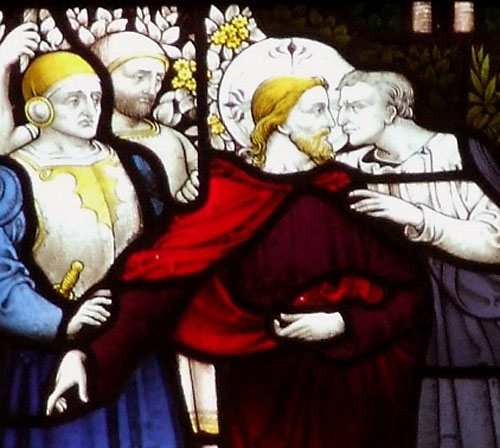
A nice and unique feature of the new Norwich SG website is an area called Trails, which are maps that have mini-tours of 3-4 churches at a time that you can travel to on your own. It's a great idea. I wish other SG websites would try it out.
April 29, 2008
Nine Views of Springtime
Saw this first on a Fox & Clover Flickrset
Nature themes. Illustrative. Simple, straightforward. Nice.
Cloud Trees
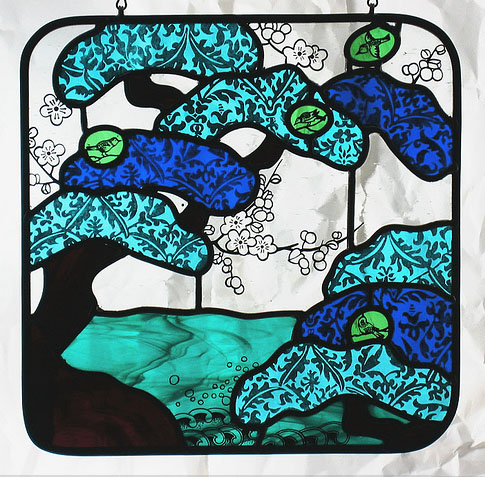
In the Flowers
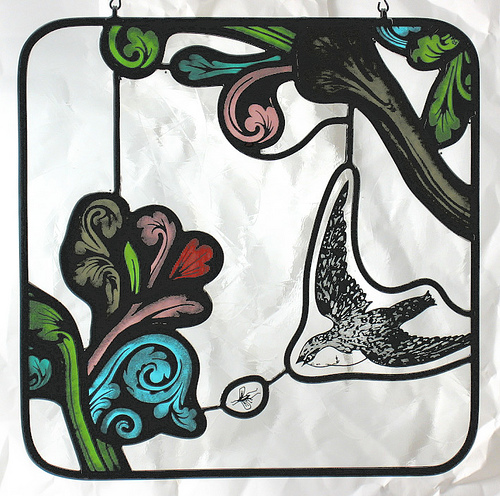
December 16, 2007
Vidimus 13, The King's Glass, and The Treasure of Abbot Thomas
Vidimus, which boasts of being the only online magazine devoted to medieval stained glass, has been around for about a year and is always worth a look through.
The December 2007 issue reviews the new book The King's Glass, by Carola Hicks. Amazon describes the book as such - "Monarchs and makers. The tense, captivating story of the glorious windows of the King's College Chapel, Cambridge". Translation - the book is about the stained glass of King's College Chapel, with a focus on the makers of the glass, mostly Flemish immigrants. Sounds like a great premise for a book, as there are far too few books on stained glass that deal with the designers and fabricators who actually make the stained glass. You can see other reviews of The King's Glass at the Telegraph online and the Times Online.
I visited King's College Chapel about 17 years ago and I have to say I liked the side chapel glass better than the big bold scenic windows. Just me, as I tend to prefer the small and intimate spaces over the large and overpowering. There is no mention of it in this issue of Vidimus, but if you can find it, look for Hilary Wayment's book on the King's College Side Chapel Glass. On writing this, I tried a search for 'hilary wayment chapel glass' at abebooks.com, and I've seen it on other used book sites. If you just want to see more images of the stained glass from King's College Chapel, the great and the intimate, you can see many images with a Flickr search for 'king's college chapel glass'.
a few examples, among many -
The Top portion of the East Window - in full
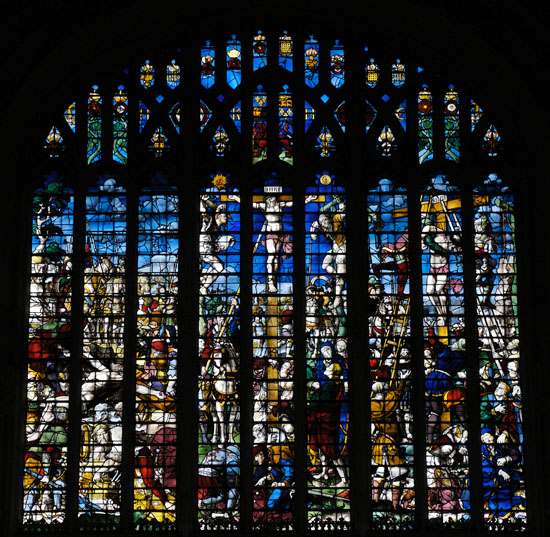
via Flickrite "nick in exsilio"
and a closer view in the lower center area - see Christ's foot at the top left in the image. I remember this as a large expanse of glass with a jumble of highly colored figures.
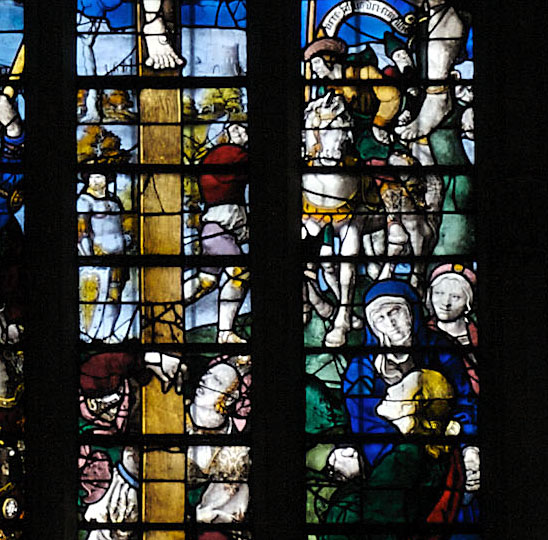
As for the Side Chapel windows, this is one of the more enigmatic of the side chapel roundels.
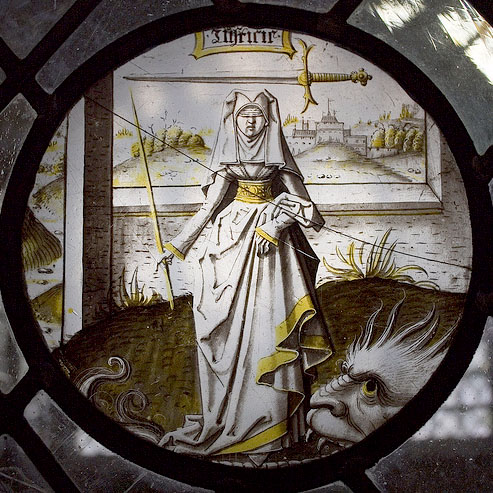
"Justice" - via flickrite twistan
Another view of the side chapel windows. This gives a better idea of the context in which you might see these, in a jumble of a different sort. Note the grasshopper - the side chapel windows contain many of these small 'nature' themed details.
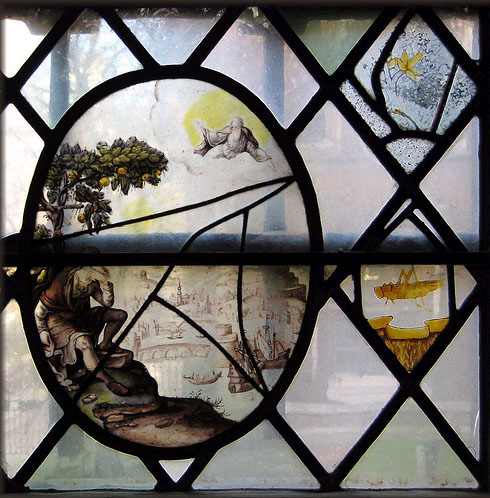
via flickrite 'frscspd'
This issue of Vidimus being the Christmas issue and there being a tradition in England for the Christmas Ghost Story, there is included a ghost story by M.R. James called The Treasure of Abbot Thomas, which features stained glass in a key part of the plot. I read the story many years ago and it was fun to read it again. Well, actually, I listened to it this time. You can find links to free audio versions of all the stories in "Ghost Stories of an Antiquary" at Librivox, which turns public domain books into downloadable audio book versions.
September 14, 2007
Hypertexting the Gothic Cathedral
In searching for info on the Bourges "Jaws of Hell" photo I posted about the other day, I came upon this 'Last Judgement Window' web page by travel photographer Stuart Whatling. It's part of an ambitious work-in-progress cataloging the Bourges Cathedral Ambulatory windows in a uniquely hypertext-oriented navigational method.
Two screenshots from the site - First, the Last Judgement Window page. You can 'read' the story in brief as text, then click to see the detailed picture. I've highlighted the areas where you would click to go to the 'Hell-mouth' section.
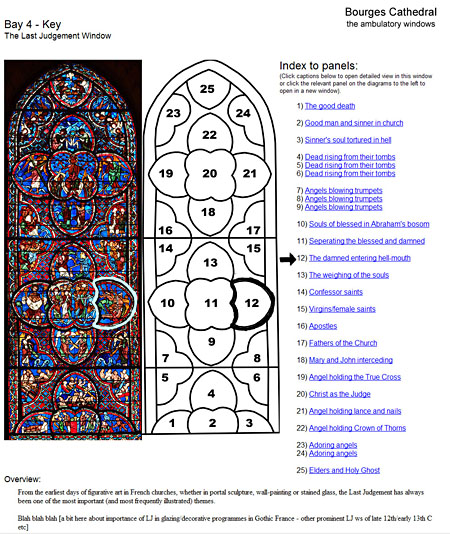
This then links to the detail of the 'Jaws of Hell' section
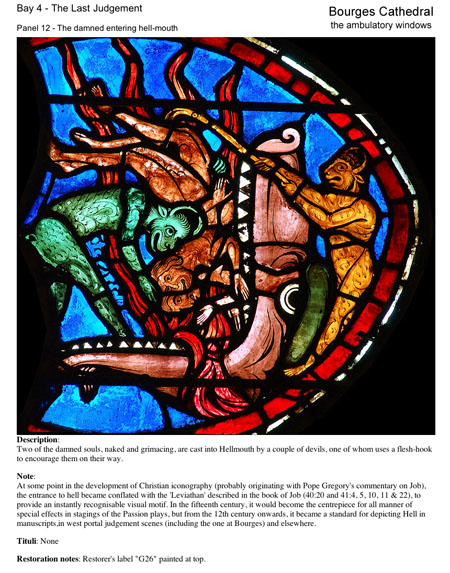
He got his idea from Alison Stone's Chartres site, hosted by the University of Pittsburgh. I linked to the Alison Stones site a while back when I did a post about Gothic Cathedral windows as comic strips. Her site remains the more comprehensive and detailed, but Stuart's is very impressive, especially considering he didn't have an academic institution backing him up. On top of that, I think his photographs are of a higher quality in general.
I only wish this kind of site could be created for all the great Gothic Cathedrals. The potential for comparison, especially in terms of narrative interpretation, is mind boggling. Just look at the Last Judgement Rose window at Chartres as compared to the Last Judgement window at Bourges ... or the Chartres Good Samaritan window compared to the Bourges Good Samaritan window.
September 11, 2007
Jaws of Hell
All in all, not a good summer, still... it could be worse...
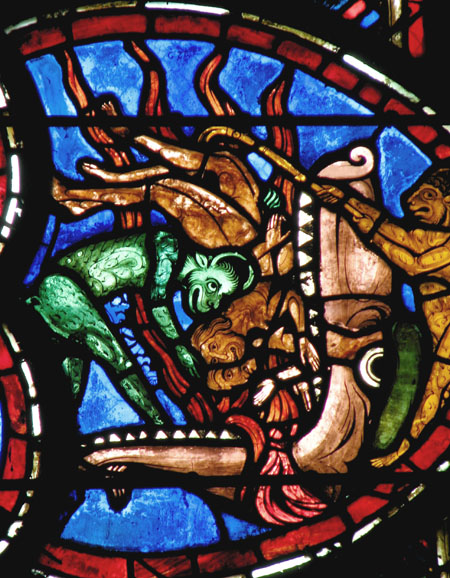
yikes.
A page from Nick in exsillo's photos on Flickr. The image is a detail from the Last Judgement window at Cathédrale Saint-Étienne de Bourges, France. Nick's photos are mostly of French Gothic Cathedrals, a large number of the photos being stained glass details. Truly truly amazing.
August 23, 2007
Barbara Giesicke Gallery
I've never seen a gallery devoted only to stained glass, unless it was attached to a working studio. The closest I've seen are galleries showcasing glass that have some stained glass as well. I found out recently that there is, in Germany, the Gallery Barbara Giesicke, that deals exclusively with stained glass art, from the 16th century to the present.
Check out all the online galleries. The 20th-21st century gallery features works By Schreiter, Stockhausen, etc. All great stuff, still, I think I like the 16th-17th century gallery best. I just can't get enough of those little Swiss panels.
August 10, 2007
Dog Chapel
From the artist Stephen Huneck, the Dog Chapel in St. Johnsbury, Vermont.

I wanted to build a chapel, one that celebrated the spiritual bond we have with our dogs, and that would be open to dogs and people. People of any faith or belief system.
Yes, the entire chapel is dog themed. Make sure to check out the Flickr pages found under Dog Chapel.
Their motto, fittingly -
ALL CREEDS
ALL BREEDS
NO DOGMAS ALLOWED
June 29, 2007
Judith Schaechter website
At long last... finally... an actual website from the one and only Judith Schaechter.
Generous supply of images (well over a hundred panels shown) and nice big images at that.
She also has a long list of links - make sure to scroll down and check out the links in 'Inspiration'.
June 05, 2007
'Alice in Wonderland' - a study in translation
I saw a postcard of this Mad Hatter panel a few years ago and always suspected it was part of a larger program of panels. Indeed it is and the full Alice in Wonderland Window can be seen as part of the website for the church where it's located - All Saints Church in Daresbury, England.
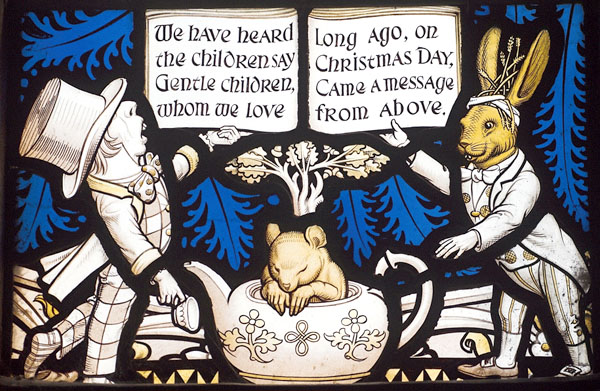
SG photography by John Eastwood
It turns out that the Mad Hatter panel is in the center of 5 small 'Alice character' panels below a larger Nativity scene.
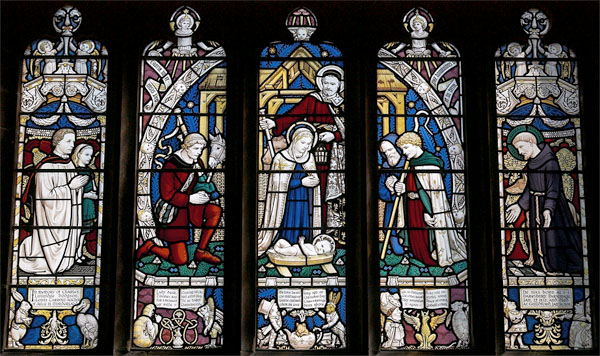
The window was created in 1935 to mark the 1932 centenary of the birth of Lewis Carroll and was created at All Saint's because it was the parish where Carroll was born (as Charles Dodgson). Lewis Carroll and Alice Liddell are depicted in the leftmost lancet. The stained glass is by Geoffrey Webb, who was a student of Charles Eamer Kempe. Stylistically, especially as regards the nativity scene, that makes sense as Kempe tended toward this kind of color scheme featuring the starkly white figures with shots of color in the clothing and background. (Bio of Geoffrey Webb - scroll down about a quarter of the page)
The design for the all of the 'Alice in Wonderland" characters are, of course, based on the famous illustrations designed by John Tenniel. I thought it would be interesting to get a detailed look at the how closely the original illustrations, designed by John Tenniel were translated into stained glass.
Mostly pictures, with some written commentary - going left to right -
White Rabbit and Dodo Panel
The stained glass panel.
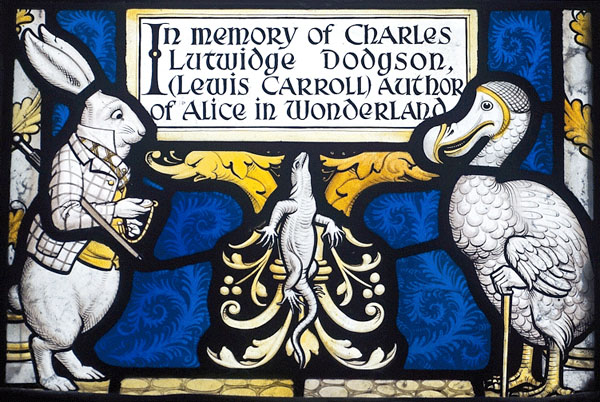
The original illustrations in full.
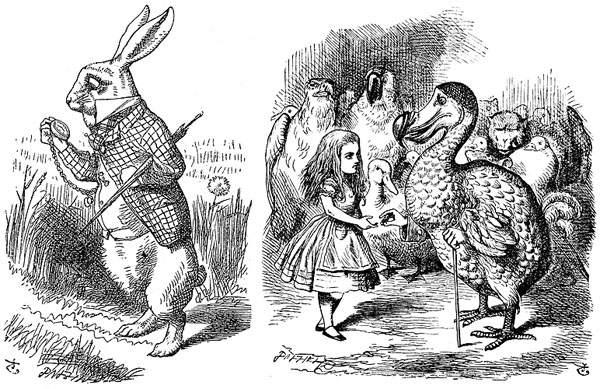
As expected, the stained glass figures have less cross hatching and feature more thick black lines. All the characters are surrounded by a fairly thick line of black. The translation to color is not jarring seeing that all the characters are on clear glass with accents in yellow silverstain. Keeping the characters all white against a dark color background gives more of the impression that the figures have stepped off the pages of the printed book. The yellow adds color which keeps them from looking too flat, yet the use of stain is subtle and doesn't overwhelm.
White Rabbit illustration and stained glass designs side by side
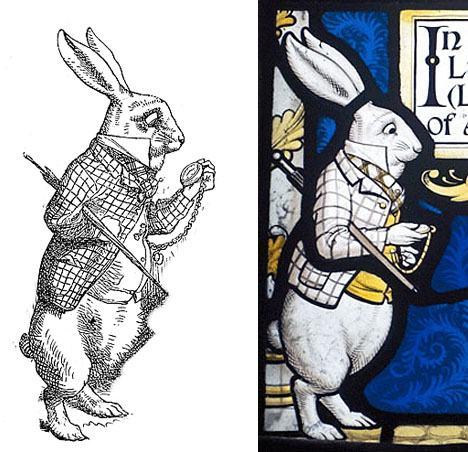
Dodo designs side by side
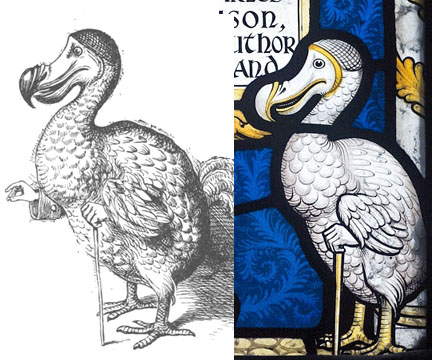
Lizard designs side by side

Caterpiller and Fish Footman Panel
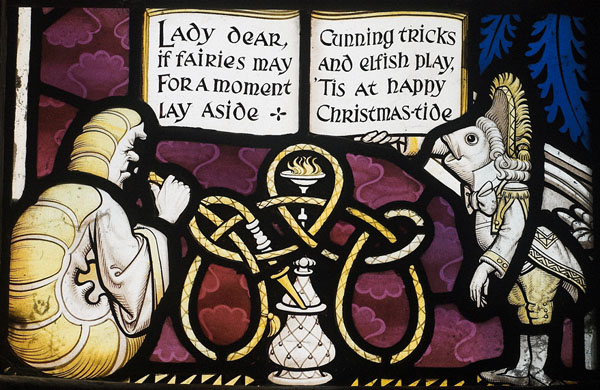
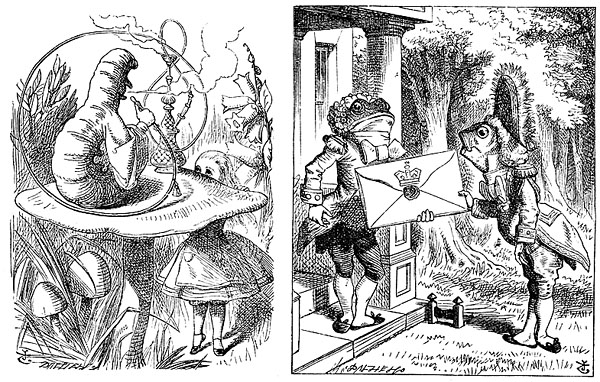
This example shows how the SG designer will sometimes take an element in the illustrations and transform it to something more conventionally stained glass like. I refer to the hookah pipe in the stained glass which, compared to the illustration, curves in a much more symmetrical fashion, much more like a decorative knot pattern one might find in a stained glass window.
Fish Footman designs side by side
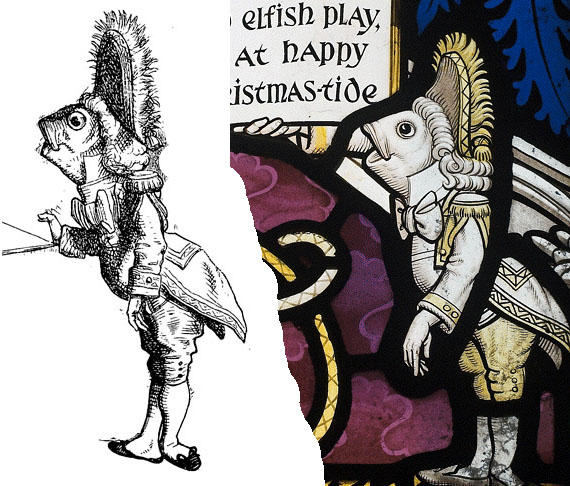
Throughout, the hands are proportionally larger in the stained glass figures and more clearly delineated. They are also, to my eye, more noticably 'human' hands. The hands are human in the prints as well, but the hands in the prints are smaller and sketchier, not calling attention to themselves as much. The Frog Footman is a good example.
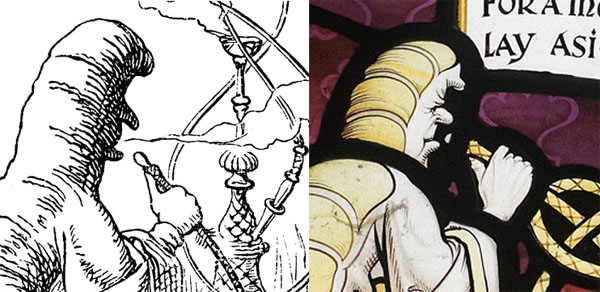
The caterpillar is unique in that the SG designer sees fit to delineate a face where there was only a shadow in the original illustration.
Mad Hatter, Dormouse and March Hare Panel

The Mad Hatter is the one character whose design does not derive directly from any of the Tenniel illustrations. It's curious since the Mad Hatter is depicted five times in 'Alice in Wonderland', more than any other character save Alice herself.
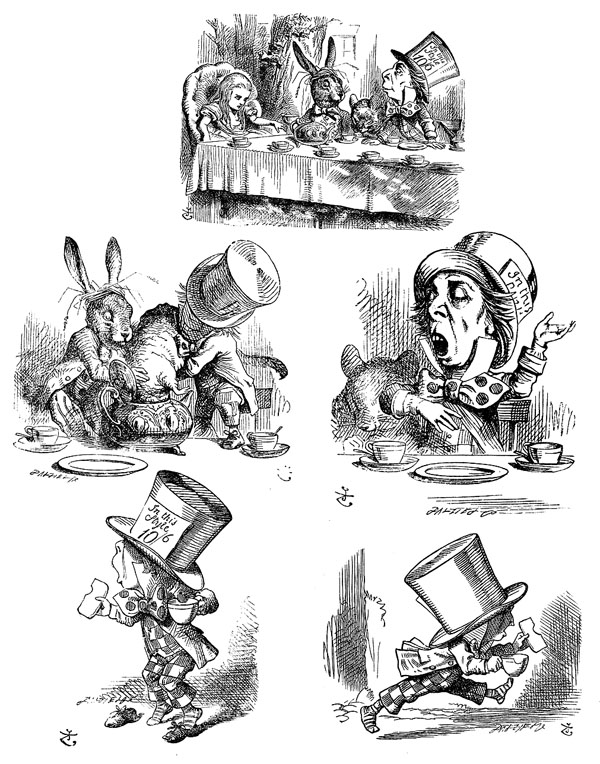
The head of the March Hare is derived from the main tea party scene though the Hare's body is original to the stained glass. The dormouse is roughly taken from the main tea party scene, though again the SG designer makes the hands larger and curiously more realistic human-looking hands.
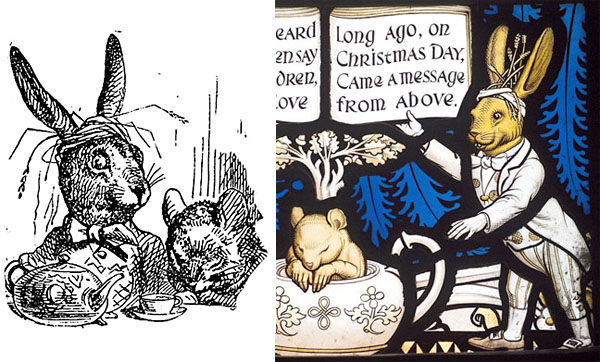
Duchess, Griffin and Mock Turtle Panel
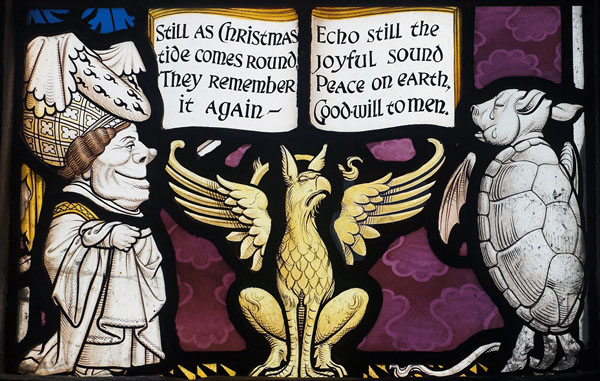
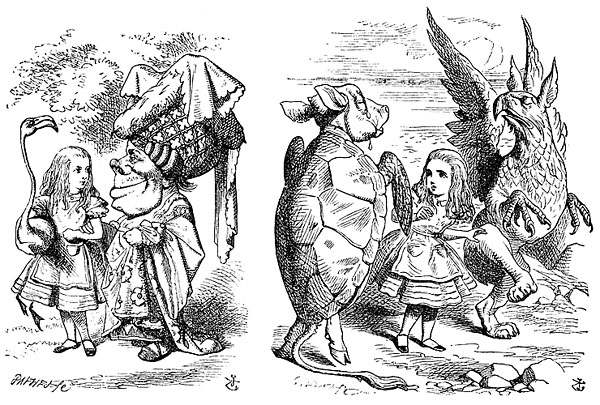
Note that only the head of the Griffin is derived from the above illustration(reversed) while the design of the body and wings of the griffin is new to the stained glass and again are more 'stained glass like, note the symmetry. The wings, especially, look more like Kempe than Tenniel.
Duchess designs side by side
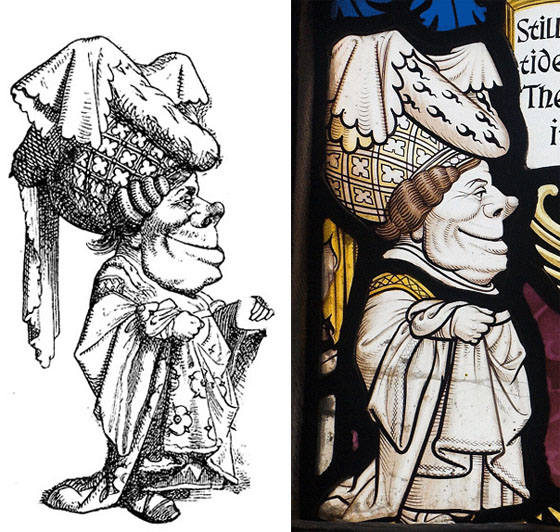
Mock Turtle designs side by side
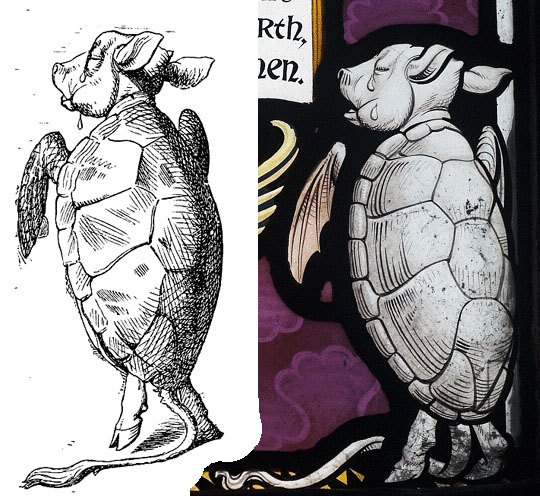
Note the linework. Both are beautiful in their own way but they are different interpretations. Both are, in fact, translations of an original design by Tenniel.
Many assume the original illustrations are pen and ink drawings by Tenniel, but they aren't. In the printed version, the linework was interpreted by the wood engraver, in this case by the Dalziel Brothers. Tenniel drew in pencil on a whitewashed block of wood and the lines were created by carving out the areas of white and leaving the areas representing black lines raised on the wood block.
In the case of the stained glass, the linework was interpreted by painting black lines on glass with a brush. With a brush, there is a more curving line and a greater emphasis on thin to thick lines.
Knave and Queen of Hearts Panel
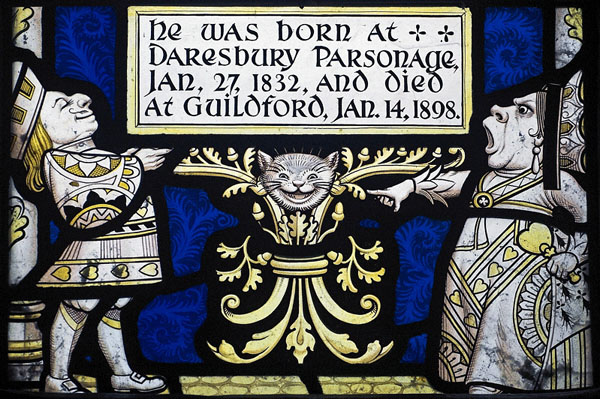
This is the only panel that features two full figures coming from the same illustration.
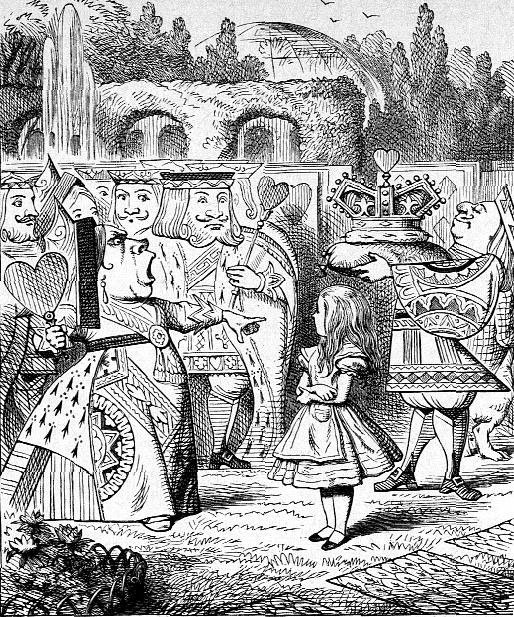
Queen of Hearts designs side by side
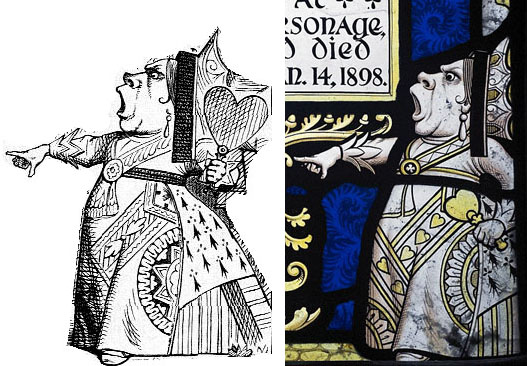
One thing that pops out to me is how the ornamentation on the clothing has changed from illustration to stained glass. The stained glass features heart designs on the clothing while the printed illustration does not.
Knave of Hearts designs side by side
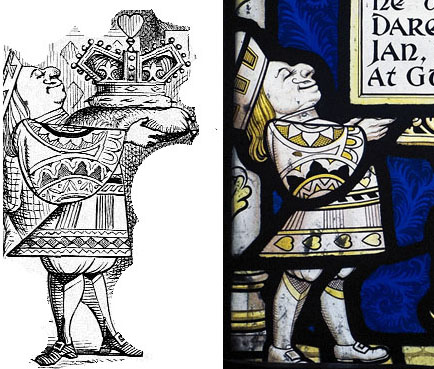
'Alice in Wonderland' - a study in translation
I saw a postcard of this Mad Hatter panel a few years ago and always suspected it was part of a larger program of panels. Indeed it is and the full Alice in Wonderland Window can be seen as part of the website for the church where it's located - All Saints Church in Daresbury, England.

SG photography by John Eastwood
It turns out that the Mad Hatter panel is in the center of 5 small 'Alice character' panels below a larger Nativity scene.

The window was created in 1935 to mark the 1932 centenary of the birth of Lewis Carroll and was created at All Saint's because it was the parish where Carroll was born (as Charles Dodgson). Lewis Carroll and Alice Liddell are depicted in the leftmost lancet. The stained glass is by Geoffrey Webb, who was a student of Charles Eamer Kempe. Stylistically, especially as regards the nativity scene, that makes sense as Kempe tended toward this kind of color scheme featuring the starkly white figures with shots of color in the clothing and background. (Bio of Geoffrey Webb - scroll down about a quarter of the page)
The design for the all of the 'Alice in Wonderland" characters are, of course, based on the famous illustrations designed by John Tenniel. I thought it would be interesting to get a detailed look at how closely the original illustrations, designed by John Tenniel, were translated into stained glass.
Mostly pictures, with some written commentary - going left to right -
White Rabbit and Dodo Panel
The stained glass panel.

The original illustrations in full.

As expected, the stained glass figures have less cross hatching and feature more thick black lines. All the characters are surrounded by a fairly thick line of black. The translation to color is not jarring seeing that all the characters are on clear glass with accents in yellow silverstain. Keeping the characters all white against a dark color background gives more of the impression that the figures have stepped off the pages of the printed book. The yellow adds color which keeps them from looking too flat, yet the use of stain is subtle and doesn't overwhelm.
White Rabbit illustration and stained glass designs side by side

Dodo designs side by side

Lizard designs side by side

Caterpiller and Fish Footman Panel


This example shows how the SG designer will sometimes take an element in the illustrations and transform it to something more conventionally stained glass like. I refer to the hookah pipe in the stained glass which, compared to the illustration, curves in a much more symmetrical fashion, much more like a decorative knot pattern one might find in a stained glass window.
Fish Footman designs side by side

Throughout, the hands are proportionally larger in the stained glass figures and more clearly delineated. They are also, to my eye, more noticably 'human' hands. The hands are human in the prints as well, but the hands in the prints are smaller and sketchier, not calling attention to themselves as much. The Frog Footman is a good example.

The caterpillar is unique in that the SG designer sees fit to delineate a face where there was only a shadow in the original illustration.
Mad Hatter, Dormouse and March Hare Panel

The Mad Hatter is the one character whose design does not derive directly from any of the Tenniel illustrations. It's curious since the Mad Hatter is depicted five times in 'Alice in Wonderland', more than any other character save Alice herself.

The head of the March Hare is derived from the main tea party scene though the Hare's body is original to the stained glass. The dormouse is roughly taken from the main tea party scene, though again the SG designer makes the hands larger and curiously more realistic human-looking hands.

Duchess, Griffin and Mock Turtle Panel


Note that only the head of the Griffin is derived from the above illustration(reversed) while the design of the body and wings of the griffin is new to the stained glass and again are more 'stained glass like, note the symmetry. The wings, especially, look more like Kempe than Tenniel.
Duchess designs side by side

Mock Turtle designs side by side

Note the linework. Both are beautiful in their own way but they are different interpretations. Both are, in fact, translations of an original design by Tenniel.
Many assume the original illustrations are pen and ink drawings by Tenniel, but they aren't. In the printed version, the linework was interpreted by the wood engraver, in this case by the Dalziel Brothers. Tenniel drew in pencil on a whitewashed block of wood and the lines were created by carving out the areas of white and leaving the areas representing black lines raised on the wood block.
In the case of the stained glass, the linework was interpreted by painting black lines on glass with a brush. With a brush, there is a more curving line and a greater emphasis on thin to thick lines.
Knave and Queen of Hearts Panel

This is the only panel that features two full figures coming from the same illustration.

Queen of Hearts designs side by side

One thing that pops out to me is how the ornamentation on the clothing has changed from illustration to stained glass. The stained glass features heart designs on the clothing while the printed illustration does not.
Knave of Hearts designs side by side

May 18, 2007
Church of England Stained Glass Artists
This link was making the rounds recently on the usual SG forums - ChurchArt, from the Church of England
One page specifically features Contemporary English Stained Glass artists. It's unusual and interesting to see a grouping like this as it gives a rare snapshot of contemporary stained glass design, even though I know it's far from a complete list, even of British Stained Glass artists. There is certainly no web equivalent for U.S. SG artists.
Sad to report that there are quite a lot of dull designs being put forth these days. Of all the artists represented here, I still like the work of Frans Wesselman the most. I think what I like most is the directness, the simple representational imagery, and the gentle quiet expression. Nice and unusual work.
February 03, 2007
Peadar Lamb
Not seen this before.
A nice bold illustrative style.
The Unhappy Passengers II
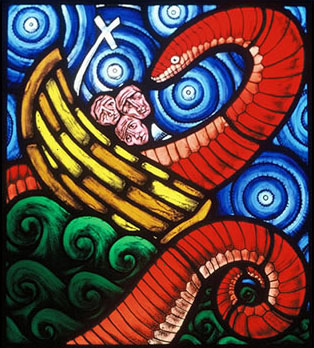
January 20, 2007
Fiammata
Recently stumbled upon the website of Justyn Zolli. Curious in that we could well have crossed paths at some time. We attended the same school (Museum School-Boston), only he was there a few years after I was. Also, he seems to have worked in more than one Boston area SG studio. I'd be surprised if we didn't have mutual acquaintances.
He also does a blog with many, many nice pictures of stained glass.
Worth a good long browse.
December 28, 2006
French War Memorial
Seen recently on Flickr - again from Simon_K
The Commune of Ney is a rather scruffy suburb of Champagnole, but the parish church is beautiful. It has also benefited from some rather striking 1920s glass, including this extraordinary war memorial window. It depicts Mother France standing on a battlefield, and offering up her dead children to Christ. Each soldier is represented by a fruit which is being plucked from a tree, but the face of each of them is a real photograph. I had never seen anything like this before.
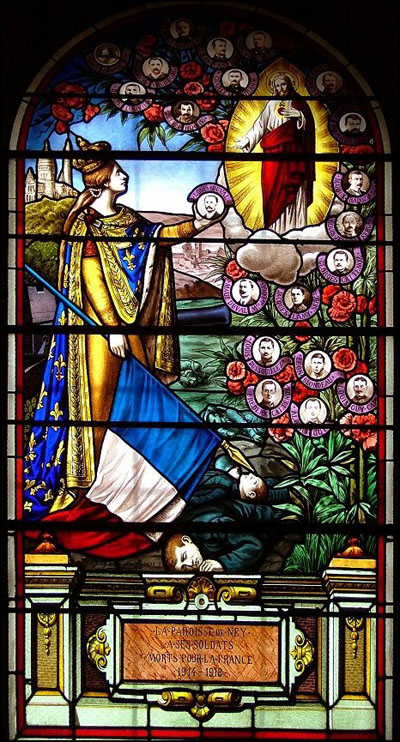
At first glance the circle portraits appear to be transferred from actual photographs by some mechanical means (decal, screenprint, etc.). But looking at the closer shots I think they are painted in the standard painting method of trace and matte, only in a very photorealistic style and almost certainly based on actual photographs. Still, it makes for an interesting stylistic mashup.
one closer shot
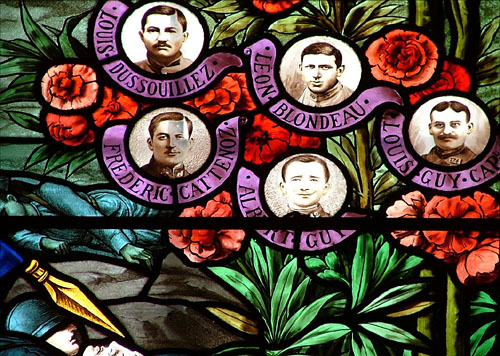
and an even closer look
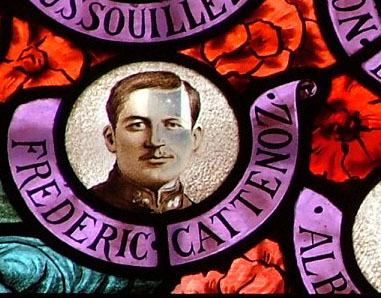
Peace on Earth
December 23, 2006
Another Moonman
Another Moonman on Flickr
this time courtesy of the 'Glass' section of Simon_K
15th century
Burnham, Deepdale in Norfolk, England
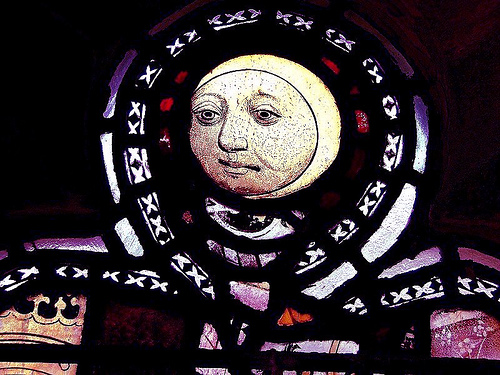
June 19, 2006
Glencairn Museum
While I'm absorbing the material from the GAS Conference, I wanted to post this about the Glencairn Museum. Ken Leap has been involved with them of late and it's an amazing place if you are interested in stained glass at all. I visited there some twenty years ago and would love to make another trip soon.
Highly recommended.
Flight Into Egypt, circa 1145, Abbey of St. Denis, Paris
now in the Glencairn Museum, Bryn Athyn, Pennsylvania
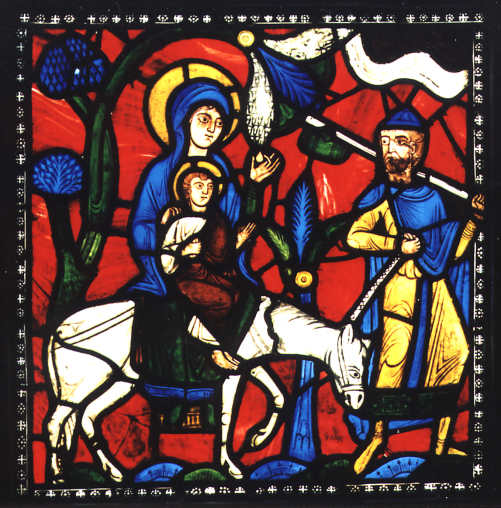
May 18, 2006
Stained Glass Exquisite Corpse online
There are new pages up for the Stained Glass Exquisite Corpse Project.
This is something I took part in about 10 years ago with a group of 11 other artists. Alice Johnson and Nancy Nicholson ran the project and it's now been accepted into the GAS Conference Juried Live Auction happening in St. Louis on June 17th. I hope it finds a good home. It was such great fun to be a part of this and so nice to be a part of a collaborative and cooperative stained glass project.
A true rarity.
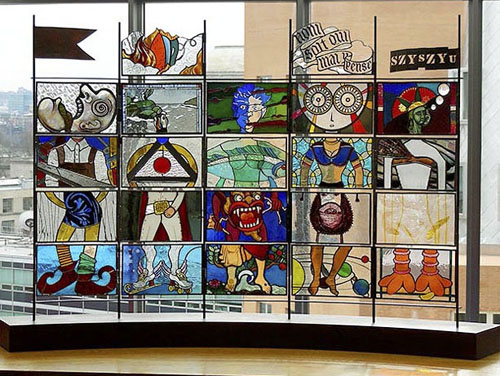
March 26, 2006
The Neustadt Collection of Tiffany Glass Site
Speaking of Tiffany... it's interesting to see the current exhibit from The Neustadt Collection of Tiffany Glass includes an exhibit of sheet glass and pressed glass from Tiffany's own furnaces. With my humble experiments in making glass for my stained glass I've gained a greater appreciation of Tiffany's accomplishment in creating sheet glass for their own windows. To my knowledge no other studio in the modern era (≈150 years) has made their own sheet glass - the sheer volume of it, let alone the quality, is just mind-boggling.
February 05, 2006
New Features at Connick site
There are now links to Connick commissions at the Charles Connick Foundation website. The descriptions of how to get to the pictures through the links can be a bit confusing but it's worth the time to figure it out if you are a Connick enthusiast.
January 28, 2006
Happy New Year
The Chinese character for Good fortune in stained glass. The colors seem a bit primary, but I like the idea and the linework.
January 12, 2006
Nice Page at the V & A
Nice stuff to be found at the Sacred styles of Stained Glass at the Victoria and Albert Museum page. - good stuff like -
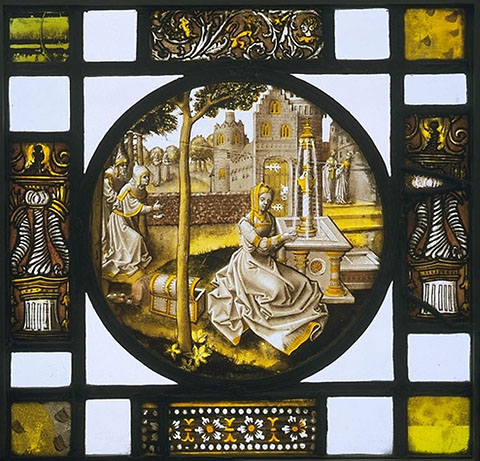
December 25, 2005
more Flickr-ing
Browsing Flickr on this day off of work... searching the 'stainedglass' tag, now over 5,600 images!
there is not a full shot of this - only this enigmatic closeup.
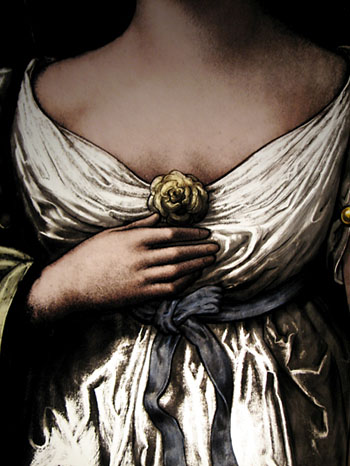
...also came across this rather unusual Christ child - again no full window shot
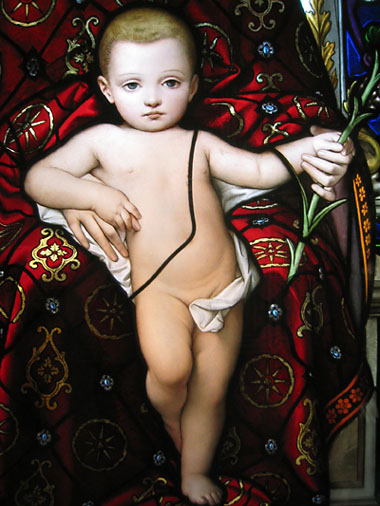
December 03, 2005
Michelli Updated
I got a note from Pippin Michelli, Ph.D of Art History with Michelli that the Stained Glass History section has lots of updated links and new sites it's linking to. I had noted this site almost 2 years ago and it remains one of the best and most varied sites for stained glass links I've come across.
October 07, 2005
Ely Stained Glass Museum website
I hadn't checked out the website for The Stained Glass Museum at Ely for awhile.
Lots of good stuff in there, especially in the realm of quirky 20th century designers. Such as -
Evie Hone
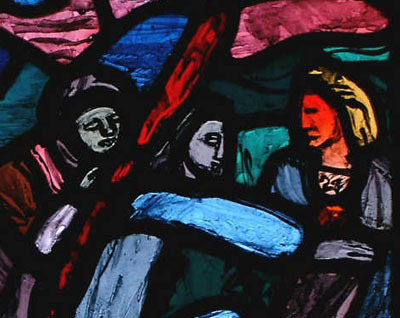
Margaret E. Aldrich Rope
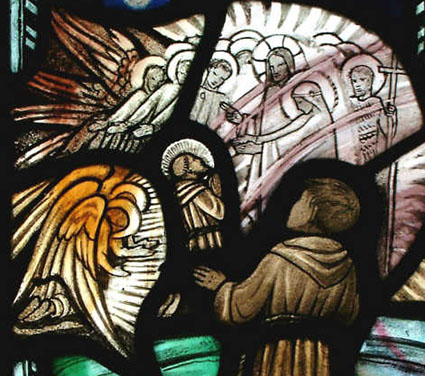
Moira Forsyth
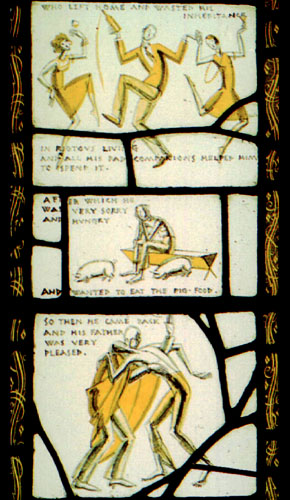
with detail - fuzzy but still good to see
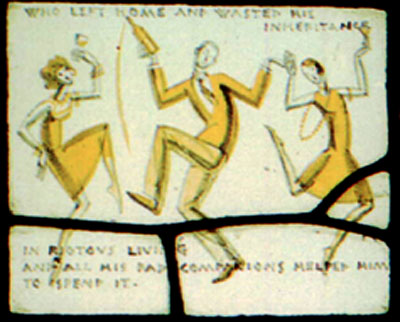
Jazz age prodigal son. I like.
I wish more designers played around with ideas like this.
September 22, 2005
Shakespeare Stained Glass Links
What with the previous Shakepeare piece, I thought I would post some of the links I've found for Shakepeare themed stained glass. Surprisingly, there is not much to be found on the web.
A studio with a Shakespeare commission out of England. Looks like an interesting window, though it's hard to tell as it's a small picture on a really clunky website.
This Seven Ages of Man window for the Folger Shakespeare Library in DC, designed by Nicola d'Ascenzo. Though it seems technically adept, it also seems to lack a certain vivacity. I'd have to see the actual window. I've longed to visit the Folger.
The Shakepeare window at Memorial Hall at Harvard University. The Shakespeare window is about halfway down the page.
Other than a few simple undistinguished medallion panels, that's it. Curious.
September 04, 2005
The Comics Thing
I came across this page with a reading of the Good Samaritan window at Chartres Cathedral. Here is the diagram - it's bigger when you follow the link
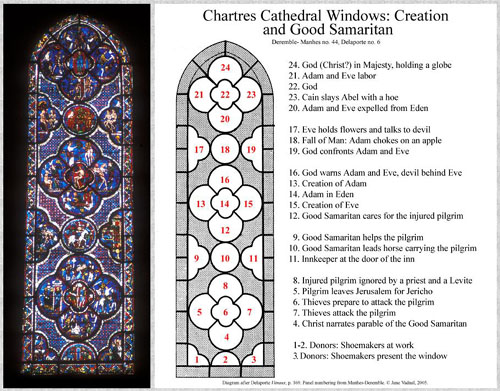
I have long thought of the possibilities of stained glass as 'sequential art'. This page reminds me once again that there is a precedent for it. I witnessed this window being 'read' as a story by the long time English guide at Chartres, Malcom Miller, and I remember thinking at the time - this thing is a comic strip!
The Good Samaritan/Creation window is especially interesting to me in that it translates so directly into the form of a modern comic strip, except that it goes bottom to top rather than top to bottom. It certainly has panels with gutters - gutters being the bands of space outside story panels that are usually blank, but here are highly colorful and ornamental.
I also love the sophisticated narrative. Two stories on top of each other that then relate to each other. The telling of the Good Samaritan first, then the story of Adam and Eve. The idea being that the act of compassion by the Good Samaritan is a metaphor for Christ's act of compassion in sacrificing his life for fallen man - Christ is the Good Samaritan. Unfortunately, this sequential element was never developed further in stained glass past the 14th century or so, and certainly does not exist at all today.
August 24, 2005
Talk about adventures in a dangerous art.
A website featuring the stained glass computer case. This case, called Hemophilia, is bold in color if disturbing to read about -
... I titled this case “HEMOPHILIA” due to the red of the glass, my many wounds from working on this case, and the fact that I have hemophilia (a rare genetic blood disorder that hinders my blood from clotting.)...This case took 62 hours and 19 minutes to build during the span of three weeks. I received 9 nasty cuts, 5 burns and I consumed 464 oz. of Mountain Dew while creating this case. The Dew also works wonders on soldering-iron burns.
August 18, 2005
Met Museum Stained Glass
Nice selection of stained glass on the Met Museum website.
The Metropolitan Museum of Art in NYC remains my favorite museum of all.
July 23, 2005
Belcher in Michigan
A page about Belcher Mosiac windows - part of the Michigan Stained Glass Census website. Amazingly, the patents for the Belcher process are accessible online, complete with diagrams showing the process.
The host site for the patent , peninsulators, is interesting in itself, being a site devoted to glass insulators and glass prisms.
March 18, 2005
Islamic Stained Glass Illuminations
Came across this site a few weeks ago, again out of the UK - Islamic Stained Glass Illuminations by Alan Baker. I've long thought that Islamic design would be well translated into stained glass. This shows that it's true. I would like to see the pieces themselves as I've seen some things like this that come off better in the photograph than in the panel itself.
Still, I like the effort.
One note on the website - lose the animated gifs!!! It's a really, really bad web design faux pas.
March 10, 2005
Who says stained glass is boring...
While strolling through the CVMA picture archive - came upon some nice monsters.
January 23, 2005
Wholeo
via an email stained glass group...
Recently heard of this project - the Wholeo Dome
and the accompanying story of its rebirth. Very wild.
Takes me back to the 70's, when I started doing and looking at stained glass.
July 15, 2004
SGAA Boston 2004 - Day by Day
Note that this is my own version of the conference. I did not see everything and so cannot comment on everything. Such is conference life.
DAY ONE - Saturday, June 26, 2004
My day started with tours of Church of the Covenant and Arlington Street Church, both in Boston and walking distance from the Park Plaza, where the conference was located. Church of the Covenant has many Tiffany Studio windows, and a nice St. Francis window by Reynolds, Francis and Rohnstock. Arlington has a full program of Tiffany windows, featuring some of the very best designs by Frederick Wilson, one of Tiffany's top designers.
This is a detail of the St. Francis window, Church of the Covenant -
I especially like the birds in the lower right looking up to St. Francis.
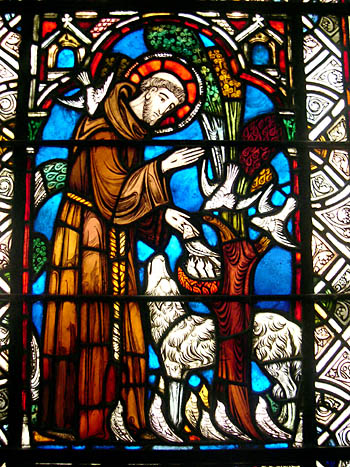
Here is one of my favorites from Arlington St. Church, designed by Wilson - "Madonna of the Flowers"
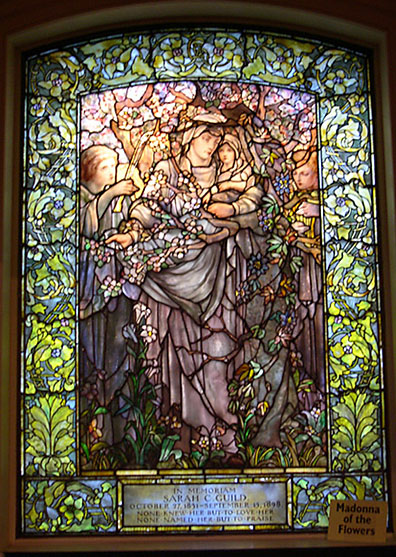
The highlight of the day was undoubtedly the talk by Debora Coombs in the afternoon. Alas, her website doesn't give the full picture. I was very impressed by the new windows she is doing at Marble Collegiate Church in NYC. What a relief to see someone emphasizing drawing as a skill needed for a stained glass artist/designer/painter.
This day also featured the first general assembly and in the evening there was the opening reception and buffet, always a good chance to reconnect with those friends and colleagues you haven't seen in a long time and meet those you have heard of but never met. The highlight here was to see and meet Albinas Elskus, who got a big round of applause when he was first introduced.
DAY TWO - Sunday, June 27, 2004
Dick Millard gave a talk on doing transparent sketches. The highlight was seeing the sketches themselves - I'd heard about them for years.
Karen Long gave a talk on lead safety. A tough, straight shooting talk about how studios need to have written lead safety compliance plans and work toward enforcing those plans. And they need to do this NOW. Some related links are the OSHA website, the OSHA lead information page, the EPA website, the OSHA small business assistance program webpage.
This is important stuff. There are still too many studios who swing wildly between denial and paranoia when it comes to lead safety. The key is in educating yourself and using common sense.
Later in the morning there was a tour of the Christian Science Church and the Mapparium. Some highlights - First, from the oldest part of the building, there were some fairly primitive opalescent windows. I like this detail from a peacable kingdom window, a subject I've long thought about doing myself.
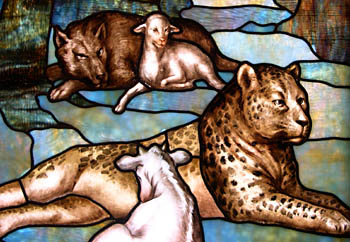
Then, in the newer part of the building, there are some nicely painted decorative windows. In general, I liked these better than the opalescent. Very solid design and well painted.
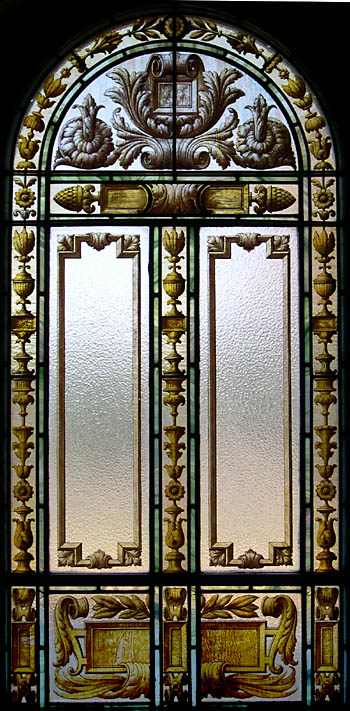
and a detail
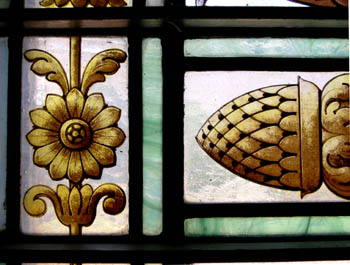
As for the Mapparium, it is stunning in some ways and pretty creepy in others. The Mapparium is a 30 foot diameter painted glass 3D representation of the earth. You walk inside it and see a light and sound show. For me, it's most interesting as a technical achievement. As an experience of a work of art, I find it pretty creepy. I may be out of step with the times regarding current exhibition practices - one could say that the Mapparium is ahead of it's time in that it presents a work of art like a theme park ride. Some might even view it as a 'conceptual installation piece'. I'm enough of a curmudgeon to say that's exactly what I don't like about it.
In the afternoon, there was a tour/talk with Julie Sloan on the windows of Trinity Church. When I lived in Boston I spent many hours in Trinity Church, so I have many fond memories here as well, and my own favorites. Many on the tour liked the Margaret Redmond windows more than the large imposing LaFarge windows.
My favorite remains the Baptistry Window, designed by Edward Burne-Jones.
Not a very good photo, but here it is.
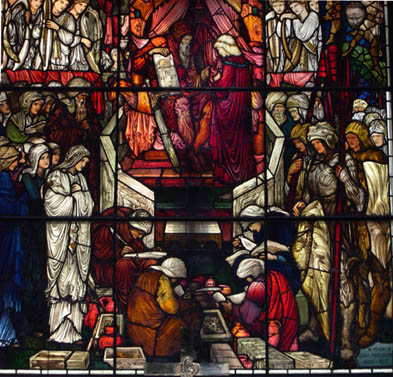
Many of the Burne-Jones windows have such little variety of character. This one is different. Alas, I could not get closer to photograph any details. This window is best in its details.
DAY THREE - Monday, June 28, 2004
In the early a.m. Barbara Kreueger spoke of her experience with doing a Statewide Survey of Stained Glass Windows for Michigan.
Then the one and only Virginia Raguin gave some historical background on American stained glass. I've known Virginia for over 20 years now and have heard her speak many times. There are few in Academia who can match her enthusiasm and energy.
There was a professional overview of current Stained Glass Conservation practices given by Art Femenella.
Jean Farnsworth gave a talk related to her book Stained Glass in Catholic Philadelphia. On this same website there is also an impressive Gallery of Stained Glass at St. Joseph's University. Lots of Munich style windows and quite a few curiosities.
Sylvia Nicolas showed some of her work, as did her son Diego Semprun Nicolas.
Alan Joslin gave a talk on the collaborative process of architect and artisan by way of talking of the creation of the Glavin Chapel at Babson College. Peter McGrain worked on this with Alan and the other artisans.
Finally, Lyn Hovey gave an overview of his studio work for the past 30 years. I worked for Lyn in the 80's so I saw quite a few familiar works and a few that I had not seen before.
That evening there was a reception at the Boston Public Library sponsored by the Connick Foundation. Much credit should be given to Marilyn Justice of the Connick Foundation to get the exhibit up and running on short notice.
Unfortunately, the website for the Connick foundation still does not have any gallery yet, or even links to any Connick sites. The least they could do is to include some links to websites that feature Connick windows, such as this one for the Alexander Browning Library in Texas... or this from All Saint's Parish Church in Brookline, Mass. This church contains Connick windows spanning from 1912 to 1986!
DAY FOUR - Monday, June 29, 2004
In the morning I visited the studio of Dan Maher. I've known Dan for over 20 years and worked with him and for him for many years. He showed me a nice commission for a Memorial Window he had just finished for Youville Hospital in Cambridge, Mass. A detail -
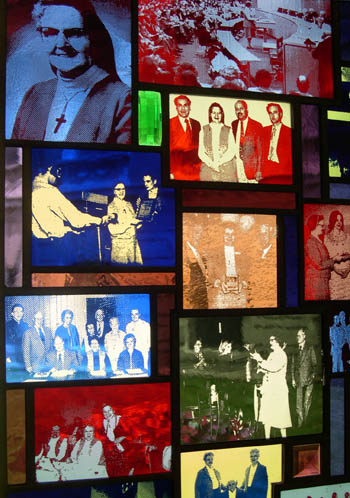
There is no paint on these windows. This is all done on flashed glass. Great stuff!
I went back to the conference in the afternoon to hear the talk by Dick Millard on "The Educational Challenge". For those who do not know him (and in the professional world of stained glass there are very few who do not know him) Dick Millard has been working professionally in stained glass for something like 50 years. He is, to put it mildly, outspoken in his opinions.
He gave some background on 'the education of the stained glass artist' in the past 50 years. It was most interesting to hear his description of going through the now defunct 'formal apprenticeship program' back inthe 50's, along with the likes of Albinas Elskus. He then gave a rather scathing assessment of efforts by the SGAA over the years to incorporate the idea of education into their activities (unfortunately, the failure of the "Stained Glass School' at Flagler College made for a low buzz throughout the entire conference).
He then went into his own vision for a stained glass education. The various components, a course of study, that would make for a well rounded stained glass artist. Most of it concentrating on the technical aspects, emphasizing integrity (no nepotism) and quality (choose the best, not the best connected). I would agree with Dick in that the biggest obstacle remains the attitudes of the studios themselves, in hanging on to outdated ideas about the fear of 'teaching your competitors' and letting out 'trade secrets' and the like. Fear and complacency remain the biggest enemies. I would disagree with Dick in that I believe it will have to happen through fine art departments in academic institutions or, at least, art schools. Workshops and single courses through studios will not be enough.
At the very least, I hope this opens up debate on how to train and educate people for doing stained glass. It is an important issue and not an easy one. But it is the key to the future success of stained glass. There is no formal program of study in stained glass at all in the USA. There are glass programs galore, due to the popularity of the studio glass movement, but stained glass has never really fit within the studio glass movement. Those glass programs may or may not have a few classes in stained glass, but no entire course of study that is specifically for stained glass.
I like Dick Millard. I don't always agree with his opinions or his manner of delivery, but I admire his candor. We need it. I also like his stained glass work and wish there were some of it to see on the web. I could find none. It's too bad because he remains an excellent designer and painter of stained glass. I wish more people saw his work.
I was sorry that I missed the presentation by Stephen Lambert of Lambert Glass. I liked the little CD/movie from Lambert's that was part of the conference package.
On the whole the conference had much to admire and much of the credit is due to Maria Serpentino of Serpentino Studios for being the organizational force behind it all.
June 23, 2004
The Exquisite Corpse revisited
I am preparing to visit Boston to attend the SGAA Conference, so I am way busy. Therefore I will set aside the lengthier entry I had started and just announce that the Original Animated Exquisite Corpse Stained Glass Page is up and running again. Okay, the animated gif is a bit dated by 2004 standards, but it does give an idea of the fun of the whole project.
I hope, while I'm in Boston, to get some more pictures and expand on the pages for the exquisite corpse.
And yes, report on the conference as well.
May 14, 2004
Support your local glass-related virtual bookstore.
Most people in the business know of this bookstore, but here it is anyway -
The best resource for used and out of print stained glass related books is Whitehouse Books in Corning NY. Corning is, of course, a glass company town so the selection has even more glass books than stained glass books. They don't have everything but they have more than any other single resource.
and if you must (as I have mixed feelings about the idea of supporting a megalithic online bookstore), I have had good luck with searching for used books through Amazon. Recently, I got a copy of Narcissus Quagliata's From Mind to Light for $12, including shipping!
April 23, 2004
The English jumble thing
Courtesy of the Stained Glass Network ListServ, this link to a website for Corpus Vitrearum in Britain (listed by location) - Lots and lots of pictures of British Medieval and Renaissance stained glass. From York Minster to Canterbury Cathedral and many many small parish churches, there seems to be literally thousands of images to see. Quite amazing.
This does make a good place to mention my fascination with what I refer to as the "English Jumble Window".
This is a uniquely British phenomenon of stained glass where a window has been willfully destroyed (most likely by the Puritans), but some of the pieces survive and it's reassembled. That is, at a later date, someone reglazes the glass pieces into a new stained glass panel. This is done in a manner that more or less preserves the general composition but throws in old bits of other windows, clear glass or whatever-can-be-found to fill the gaps. The degree of 'jumbling' varies widely. The result is a window that, on first glance, looks like an old stained glass window with a bit of repair done. On closer examination it can seem like Cubism had its true origin in British stained glass.
A specific example - one that I actually saw myself on a trip to the Lakes District, when I visited a small parish church named Cartmel Fell in 1991. The guidebook called the East Chancel Window something like 'one of the finest and most complete examples of 15th century English stained glass". I was struck by the fact that perhaps only 20-30 percent of the original window was actually there in front of me, vaguely discernable in its composition. And I liked it. The appeal for me came partly in the detective/puzzle work of figuring out what the original scene looked like and partly a vague curiousity/fascination with the jumble itself.
East Chancel Window, Cartmel Fell
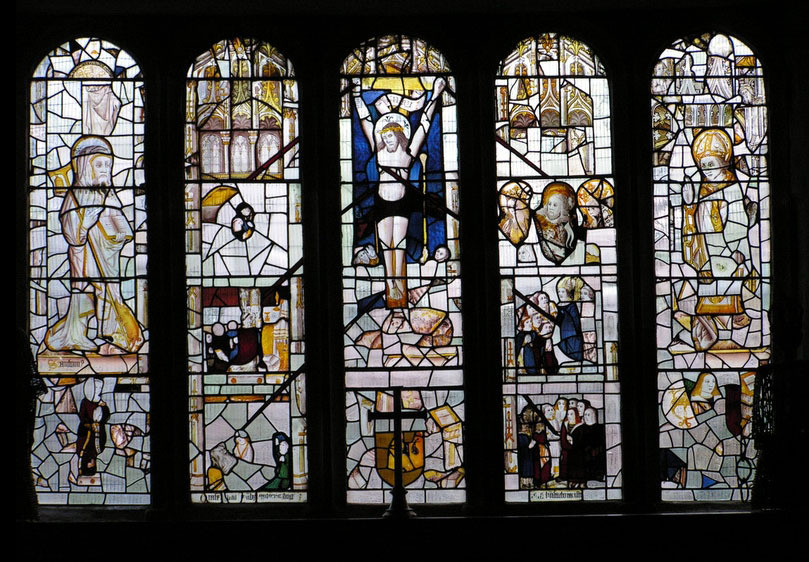
photo via davelynne - click for larger image
I have a sneaking suspicion that I might even like the jumble window better than the original window, though that's hard to prove. I just find the jumble panels to be intrinsically appealing.
My own patchwork panels are very much influenced by these English jumble panels. The patchwork panels have no pre-set design. Each panel is designed with the glass itself, using old test pieces, extras from old panels, and stock pieces of painted and etched glass. The process is one of improvisation. Sometimes it works, sometimes not. But it's never predictable.
And I like that.
[update May 18, 2009 - new better photo of the Cartmel Fell window and additonal info if you check out the page of Flickrite davelynne]
March 12, 2004
Looking at The Stained Glass Network
I finally signed up for the Stained Glass Network ListServ. They describe it thus - "The Stained Glass Network on Architectural Stained Glass is a moderated internet discussion forum that will provide a worldwide exchange of information among individuals engaged in historic research, documentation, preservation, creation or restoration of architectural stained glass." You can sign up at this page.
I have been receiving emails for about a week now and I am impressed by the quality of the posts. The viewpoints and insights are top notch. I recommend it if you are interested in stained glass, especially if you are interested in the history and conservation of stained glass. I recommend it for any artists simply because there is no other place on the net where there is a comparable attempt at an online 'community' of stained glass professionals.
My only misgiving is in the form itself, the 'listserv'. This was the main reason I had hesitated to join before (this list began in October or November of 2003). I had belonged to 'email groups' before and the idea of receiving, reading, archiving (or not) and maintaining groups of emails is something I find cumbersome. It's only been one week and I've received more than 50 emails. I do not have the time on a regular basis to skim through these, let alone have the time to fully read or make my own comments.
So I can't help but think - Why couldn't this be done as a blog?
The advantages seem obvious to me -
All in one web-based design - Current posts, with an easily read thread of comments, plus an easily accessed archive, with topics threaded for easier reading. It could still be moderated and still be by subscription only.
There could be IMAGES, critical it seems to me for a forum about stained glass, and there could be live links to other websites of interest.
Just dreaming, for now - it would take a sponsor and a few people who are at least a little internet savvy to moderate.
January 09, 2004
Another Stained Glass Blog
Happy New Year! Much to write about and not much time to write. I did come across another blog related to stained glass known as 'Stained glass, food and anything else that catches my eye blog'. This is related to a site - Stained Glass Photography - that (as it name implies) contains many photos of stained glass. The William Morris section is especially full.
December 12, 2003
Good stuff at the Getty
There is a good online exhibition called Images in Light - Newly acquired Stained Glass at the Getty Museum. This is the same museum that had the 'Painting on Light' exhibit.
A number of the other exhibits are interesting from the point of view of applying outside ideas to stained glass. The exhibits I found most interesting ->
'Comic Art' has Daumier (I love Daumier), 'Casting Characters' is about portraits, Transforming Tradition - is about Ancient Motifs in medieval manuscripts, 'Heaven & Earth' featuring depictions of Christ and the Virgin.
Well worth browsing through...
November 13, 2003
A few sites of interest
One of the reasons I am interested in doing this blog is to point out sites of interest as they relate to stained glass, contemporary and historical. There are not many good sites related to stained glass and not that much really good contemporary stained glass being produced out there. All the more important to point to the good stuff when I see it on the web.
My personal interest lies in work that is both traditional and progressive. My taste in stained glass, like my work in stained glass, is stylistically eclectic. The "style" of a given work is not as important as the particular idea involved and how that idea is executed into glass.
One of the better sites for Romanesque or Gothic work is this for the 12th century windows at St. Denis in Paris. It's an academic site notable for having detailed diagrams showing what has been restored and what is original. I have spent long periods of time going through this site.
For contemporary stained glass, I like the work of and the website for John K. Clark. I think it's the variety of his work and and the quality of execution that appeals to me most.
Finally, some links related to one of the best books on stained glass to come out in the past few years, Painting on Light by Barbara Butts and Lee Hendrix. The book is also available through Amazon. Note that the Getty Museum site has a small but impressive online Exhibition for Painting on Light.